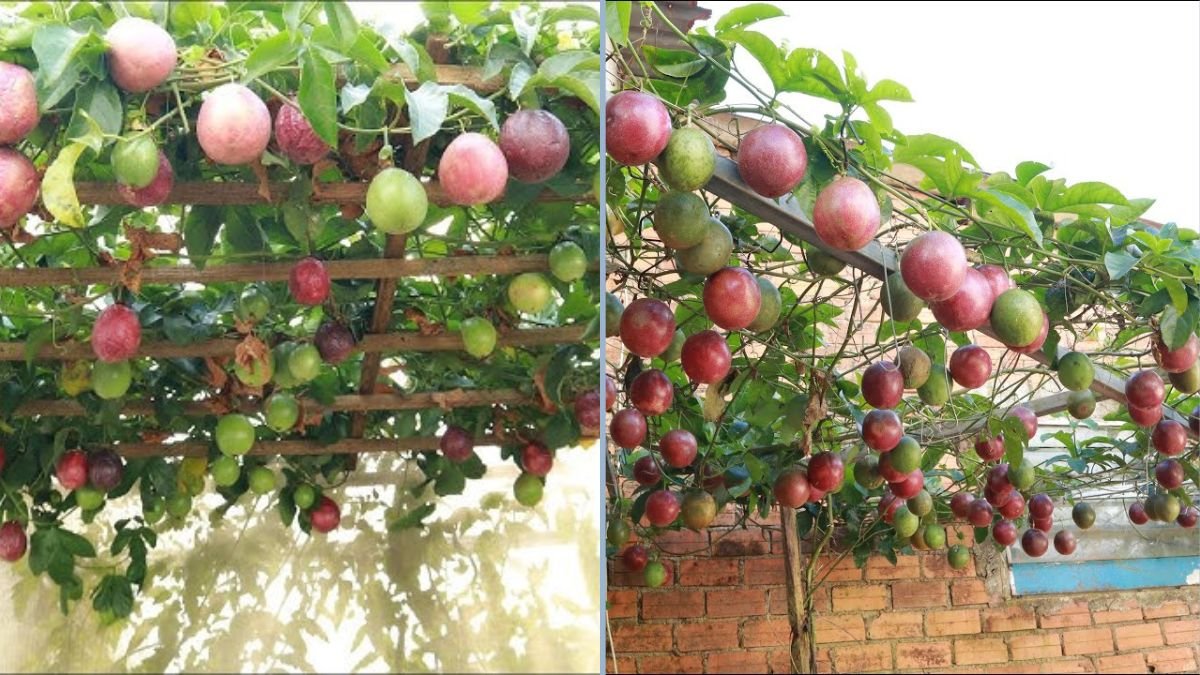Passion fruit is a tropical vine known for its aromatic fragrance, vibrant flowers, and deliciously sweet fruits. Traditionally, growing passion fruit required a garden, trellis, and plenty of space. However, with container gardening, even families without gardens can enjoy fresh, homegrown passion fruits right on their balcony, terrace, or patio.
In this detailed guide, we’ll walk you through everything you need to know about growing passion fruit in containers, from selecting seeds or seedlings to harvesting sweet, nutritious fruits.
1. Why Grow Passion Fruit in Containers?
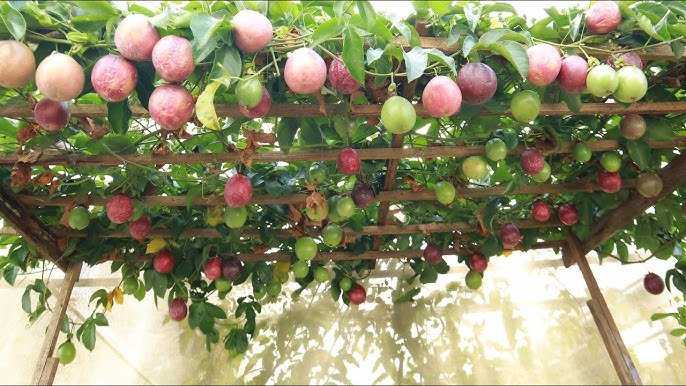
Container cultivation of passion fruit offers several advantages:
- Space-saving: Perfect for urban homes, apartments, and small terraces.
- Mobility: Move plants to optimize sunlight or protect them from harsh weather.
- Soil control: Ensure well-draining, nutrient-rich soil for healthy growth.
- Pest and disease management: Easier to monitor and control.
- Family-friendly: Teach children about gardening and enjoy fresh fruits at home.
Container-grown passion fruit plants are ideal for anyone who loves fresh fruits but lacks a traditional garden.
2. Choosing the Right Passion Fruit Variety
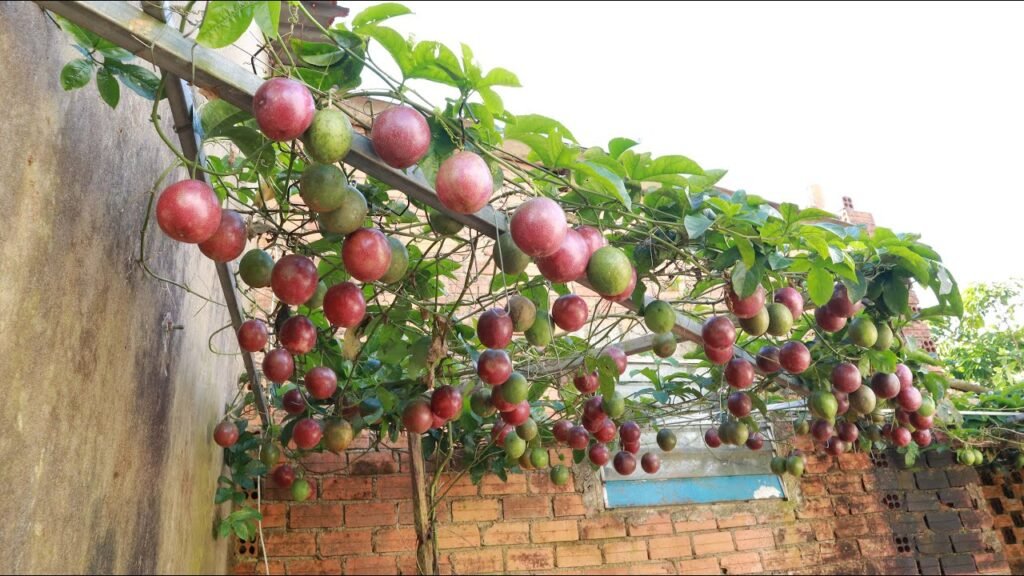
Passion fruit comes in different varieties, but some are more suited to container growth:
Popular container-friendly varieties:
- Purple Passion Fruit (Passiflora edulis): Sweet, aromatic, and ideal for small spaces.
- Yellow Passion Fruit (Passiflora edulis f. flavicarpa): Slightly larger fruits, tropical flavor, and vigorous growth.
- Dwarf varieties: Compact and perfect for balcony containers.
Selecting the right variety ensures manageable growth and consistent fruiting.
3. Selecting Seeds or Seedlings
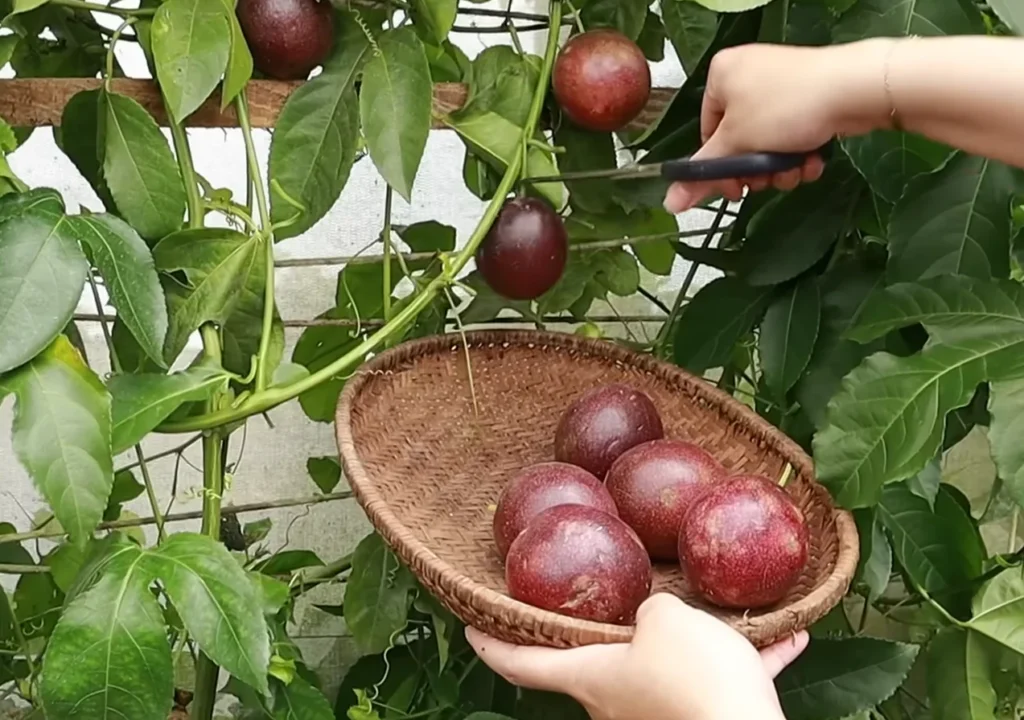
You can start passion fruit from seeds or young seedlings:
- Seeds: Extract seeds from fresh, ripe passion fruit. Wash and dry them before planting.
- Seedlings: Buying small plants from nurseries ensures faster growth and earlier fruiting.
💡 Tip: For faster results, seedlings are preferred, but growing from seeds can be rewarding and cost-effective.
4. Choosing the Right Container
The container plays a critical role in passion fruit growth:
- Size: Minimum 18–24 inches in diameter and depth. Larger pots allow more root development and better fruiting.
- Material: Plastic or terracotta pots. Terracotta provides aeration but dries faster.
- Drainage: Multiple holes to prevent waterlogging.
- Mobility: Lightweight containers help move plants easily to optimize sunlight.
A well-chosen container ensures healthy root growth and strong vines.
5. Preparing the Soil Mix
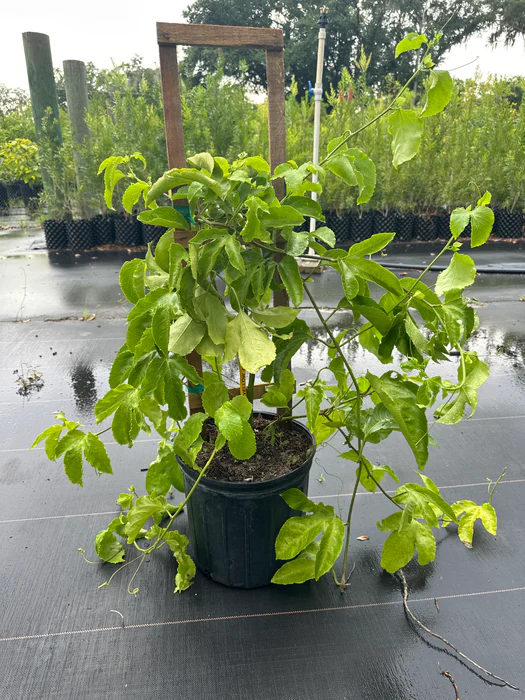
Passion fruit thrives in well-draining, fertile soil:
Recommended soil mix:
- 40% garden soil or topsoil
- 30% compost or well-rotted manure
- 20% coco peat or peat moss for moisture retention
- 10% perlite or coarse sand for aeration
💡 Tip: Avoid heavy clay soil, which can retain too much water and cause root rot.
6. Planting Passion Fruit in Containers
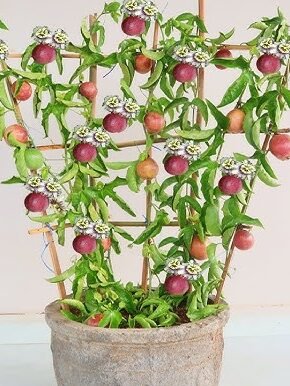
Follow these steps for successful planting:
- Fill the container halfway with prepared soil.
- Plant seedlings or germinated seeds 2–3 inches deep.
- Firm the soil gently around the roots.
- Water lightly to settle the soil.
- Add a trellis or support for the vine to climb.
Proper planting ensures stable growth and promotes strong root development.
7. Sunlight and Temperature Requirements
Passion fruit is a sun-loving tropical vine:
- Sunlight: At least 6–8 hours of direct sunlight daily.
- Temperature: Ideal range is 20–30°C (68–86°F). Protect young plants from frost.
- Air circulation: Good airflow prevents fungal infections and promotes flowering.
Providing the right environment ensures vigorous growth, lush leaves, and abundant flowering.
8. Watering Passion Fruit Plants
Proper watering is crucial for container-grown passion fruit:
- Keep soil consistently moist but not waterlogged.
- Water deeply 2–3 times per week, adjusting for temperature and rainfall.
- Mulch the soil surface to retain moisture and regulate soil temperature.
💡 Tip: Overwatering can cause root rot, while underwatering may reduce flowering and fruiting.
9. Fertilizing Passion Fruit Plants
Fertilization supports vegetative growth, flowering, and fruit production:
- Use a balanced fertilizer (NPK 10:10:10) during vegetative growth.
- Apply a phosphorus- and potassium-rich fertilizer during flowering to boost fruit set.
- Fertilize every 4–6 weeks during the growing season.
Proper nutrition ensures healthy vines and sweet, juicy fruits.
10. Supporting Your Passion Fruit Vine
Passion fruit is a climbing vine that requires support for optimal growth:
- Install a sturdy trellis, wire frame, or bamboo poles in the container.
- Train the vine gently along the support structure.
- Tie stems loosely to prevent damage and promote vertical growth.
Support ensures better sunlight exposure, airflow, and fruiting efficiency.
11. Pruning and Training
Pruning is essential to control growth and encourage fruit production:
- Remove weak, damaged, or overcrowded stems.
- Trim lateral shoots to allow sunlight penetration.
- Prune after harvesting to stimulate new growth and flowering.
Well-pruned vines produce larger, sweeter fruits and reduce disease risk.
12. Flowering and Pollination
Passion fruit plants produce beautiful flowers that attract pollinators:
- Most varieties are self-pollinating, but cross-pollination improves fruit size and yield.
- Encourage bees or use hand pollination with a small brush for indoor plants.
- Adequate pollination ensures higher fruit set and better quality fruits.
13. Harvesting Passion Fruits
Patience is key — container-grown passion fruit plants may take 8–12 months to start producing:
- Fruits are ready when they are fully colored (purple, yellow, or orange depending on the variety) and slightly soft.
- Twist or cut fruits gently to avoid damaging the vine.
- Frequent harvesting encourages continuous flowering and fruiting.
Homegrown passion fruits are rich in flavor, antioxidants, and vitamins, making them perfect for family consumption.
14. Common Pests and Diseases
Container-grown passion fruits are hardy but can face issues:
- Aphids and mealybugs: Treat with neem oil or insecticidal soap.
- Fungal diseases: Avoid wetting leaves and ensure good air circulation.
- Root rot: Prevent by using well-draining soil and avoiding overwatering.
Regular inspection ensures healthy growth and abundant fruiting.
15. Long-Term Care for Container Passion Fruit
For long-term success:
- Repot plants every 2–3 years to provide more root space.
- Mulch regularly to retain moisture and regulate soil temperature.
- Fertilize seasonally to sustain growth and flowering.
- Maintain trellis support and prune annually to manage vine growth.
With proper care, container-grown passion fruit plants can produce fruits for many years, even in limited spaces.
16. Final Thoughts: Growing Passion Fruit at Home Without a Garden
Growing passion fruit in containers is practical, fun, and highly rewarding. Families without gardens can enjoy fresh, nutrient-packed fruits by following this guide. By selecting healthy seedlings or seeds, preparing a suitable container and soil, providing sunlight, water, and support, and practicing proper pruning and fertilization, your passion fruit vines will thrive and produce sweet, juicy fruits for home consumption.
Container gardening allows urban households to create a mini tropical orchard on terraces or balconies. With patience and care, you can enjoy vibrant flowers, luscious fruits, and the joy of homegrown passion fruits year after year.
